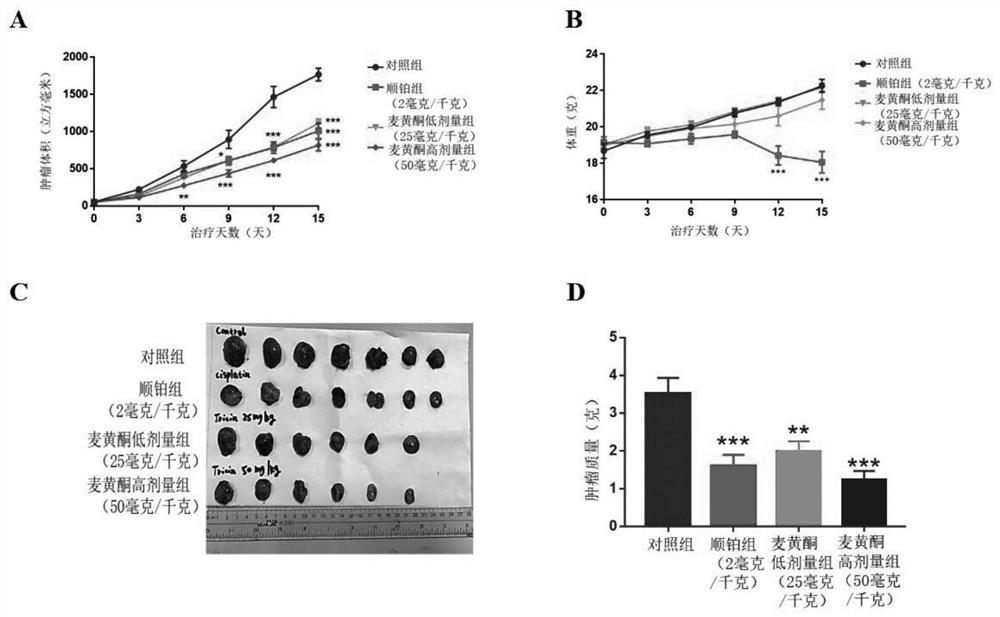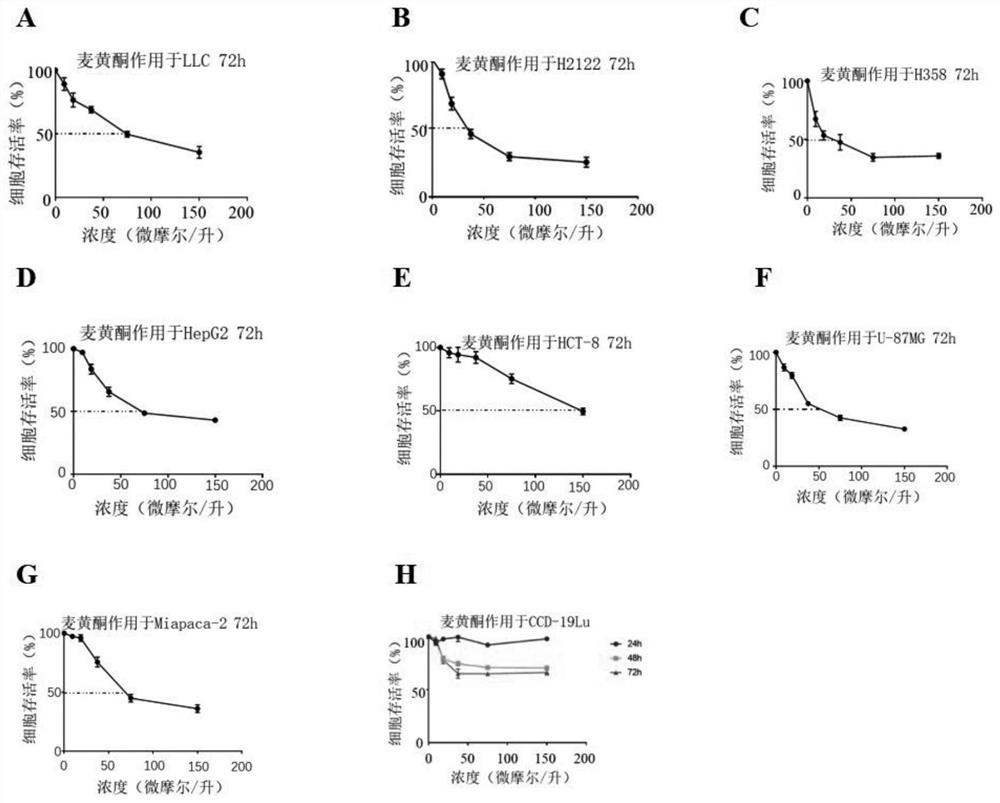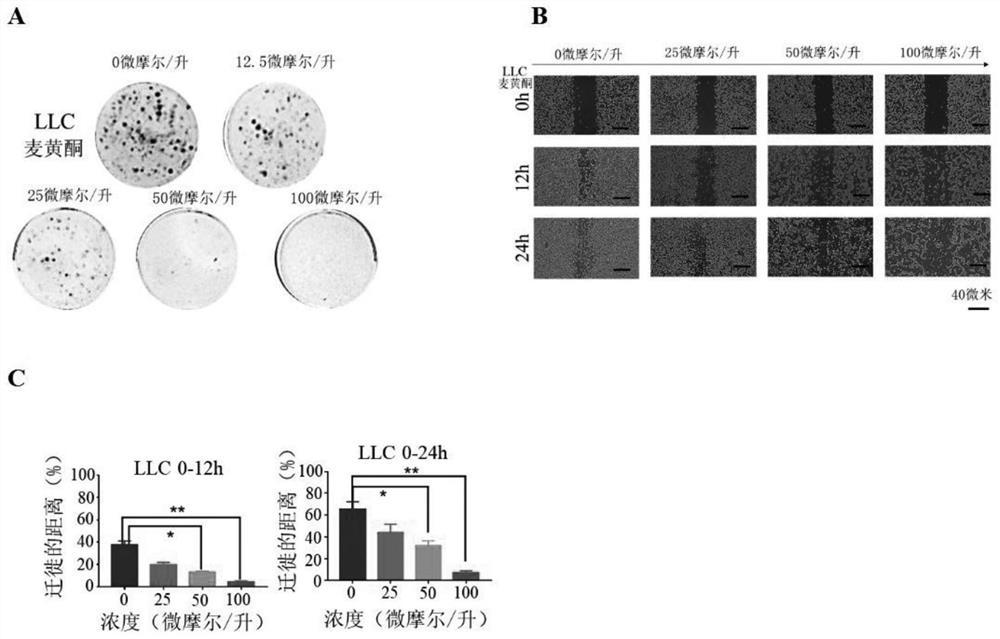Application of wheat flavone in preparation of antitumor drugs
An anti-tumor drug, tricin technology, applied in the field of medicine, can solve the problem of no cure for KRAS mutation and other problems
- Summary
- Abstract
- Description
- Claims
- Application Information
AI Technical Summary
Problems solved by technology
Method used
Image
Examples
Embodiment 1
[0032] Example 1: Establishment and intervention of tumor-bearing mouse model
[0033] Preparation of lung cancer subcutaneous xenograft tumor model: lung cancer cell line LLC cultured and passaged. Cells were collected in the logarithmic phase of the cells, and the concentration was 5×10 5 Each cell suspension in 100 μL was subcutaneously injected into the right forelimb of C57BL / 6J mice, and the tumor grew to a volume > 50 mm after about 7 days 3 , which means successful tumor grafting.
[0034] After successful tumor inoculation, the mice were randomly divided into 4 groups, 6-7 in each group, and each specific group was: 1) control group (PBS group); 2) positive control cisplatin group (2 mg / kg); 3) High-dose group of ticlavone (50 mg / kg); 4) Low-dose group of ticlavone (25 mg / kg). The PBS control group and the high-dose and low-dose ticlavone groups were intraperitoneally injected once a day, 0.2 ml each time, and the tumor volume was measured and body weight was measu...
Embodiment 2
[0036] Embodiment 2: MTT test
[0037]HepG2, HCT-8, U-87MG, Miapaca-2, LLC, H2122, H358 and CCD-19Lu cells were seeded in 96-well microplates (3000-5000 cells / well). After the cells adhered, add 100 microliters of different concentrations (150, 75, 37.5, 18.75 and 9.375 micromole / liter) of tricoflavone as the test group, and DMSO as the control group; incubate for 72 hours, then add 10 microliters MTT solution with a concentration of 0.5 mg / ml was incubated in a 37°C incubator for 4 hours. After 4 hours, the supernatant was sucked off, 100 microliters of dimethyl sulfoxide (SDS) was added, and the absorbance was measured at wavelengths of 570 nm and 650 nm with an absorbance meter. IC50 was calculated using GraphPadPrism 7.0 software, and the above experiments were carried out three times independently.
[0038] Test results such as figure 2 Shown, where A-H represent LLC (mouse Lewis lung cancer cells), H2122 (human KRAS G12C mutant lung cancer cells), H358 (human KRAS ...
Embodiment 3
[0039] Embodiment 3: Colony formation experiment
[0040] LLC cells were seeded in 6-well plates with 500 cells per well. After the cells adhered, they were incubated in tricoflavone medium containing different concentrations (0, 12.5, 25, 50, 100 micromol / liter) for about 10 days, and the medium was replaced every three days. When colony formation was evident, LLC cells were fixed with 4% paraformaldehyde (PFA) for 30 min at 4°C. Then stain with crystal violet solution for at least 30 minutes. After washing away the crystal violet solution, the colonies were photographed.
[0041] The result is as image 3 as shown, image 3 Middle A shows that ceflavone shows a dose-dependent effect on the colony formation of LLC cells; image 3 Middle B shows that ceflavone shows a dose-dependent effect on the migration of LLC cells; image 3 Middle C represents the statistical results of the migration distance of LLC cells. All experiments were carried out independently three times, ...
PUM
 Login to View More
Login to View More Abstract
Description
Claims
Application Information
 Login to View More
Login to View More - R&D
- Intellectual Property
- Life Sciences
- Materials
- Tech Scout
- Unparalleled Data Quality
- Higher Quality Content
- 60% Fewer Hallucinations
Browse by: Latest US Patents, China's latest patents, Technical Efficacy Thesaurus, Application Domain, Technology Topic, Popular Technical Reports.
© 2025 PatSnap. All rights reserved.Legal|Privacy policy|Modern Slavery Act Transparency Statement|Sitemap|About US| Contact US: help@patsnap.com



